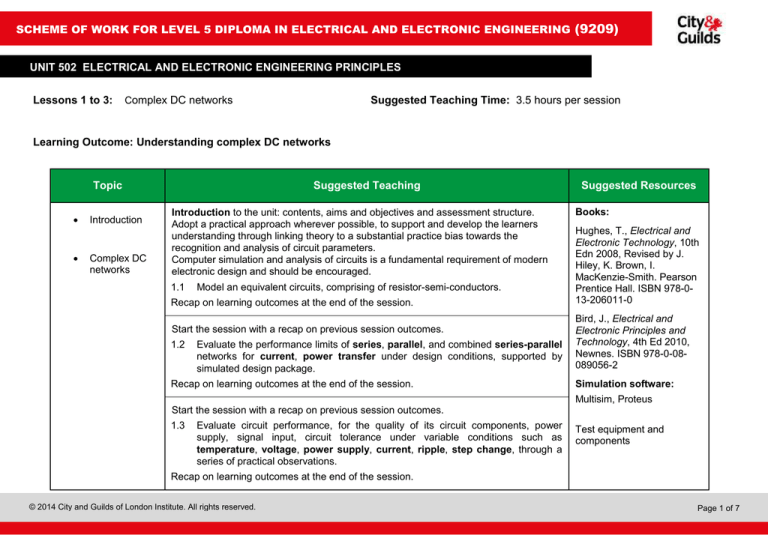
SCHEME OF WORK FOR LEVEL 5 DIPLOMA IN ELECTRICAL AND ELECTRONIC ENGINEERING (9209)
UNIT 502 ELECTRICAL AND ELECTRONIC ENGINEERING PRINCIPLES
Lessons 1 to 3:
Complex DC networks
Suggested Teaching Time: 3.5 hours per session
Learning Outcome: Understanding complex DC networks
Topic
Introduction
Complex DC
networks
Suggested Teaching
Introduction to the unit: contents, aims and objectives and assessment structure.
Adopt a practical approach wherever possible, to support and develop the learners
understanding through linking theory to a substantial practice bias towards the
recognition and analysis of circuit parameters.
Computer simulation and analysis of circuits is a fundamental requirement of modern
electronic design and should be encouraged.
1.1
Model an equivalent circuits, comprising of resistor-semi-conductors.
Recap on learning outcomes at the end of the session.
Start the session with a recap on previous session outcomes.
1.2
Evaluate the performance limits of series, parallel, and combined series-parallel
networks for current, power transfer under design conditions, supported by
simulated design package.
Recap on learning outcomes at the end of the session.
Suggested Resources
Books:
Hughes, T., Electrical and
Electronic Technology, 10th
Edn 2008, Revised by J.
Hiley, K. Brown, I.
MacKenzie-Smith. Pearson
Prentice Hall. ISBN 978-013-206011-0
Bird, J., Electrical and
Electronic Principles and
Technology, 4th Ed 2010,
Newnes. ISBN 978-0-08089056-2
Simulation software:
Multisim, Proteus
Start the session with a recap on previous session outcomes.
1.3
Evaluate circuit performance, for the quality of its circuit components, power
supply, signal input, circuit tolerance under variable conditions such as
temperature, voltage, power supply, current, ripple, step change, through a
series of practical observations.
Test equipment and
components
Recap on learning outcomes at the end of the session.
© 2014 City and Guilds of London Institute. All rights reserved.
Page 1 of 7
SCHEME OF WORK FOR LEVEL 5 DIPLOMA IN ELECTRICAL AND ELECTRONIC ENGINEERING (9209)
UNIT 502 ELECTRICAL AND ELECTRONIC ENGINEERING PRINCIPLES
Lessons 4 to 7: RLC circuits and alternating wave forms
Suggested Teaching Time: 3.5 hours/per session
Learning Outcome: Understanding the response of RLC circuits to alternating wave forms
Topic
The response of
RLC circuits to
alternating wave
forms
Suggested Teaching
Suggested Resources
Start the session with a recap on previous session outcomes.
Book:
2.1 The RLC circuit forms the basis of filter design, allowing or rejecting a
particular range of frequency. Therefore, it is essential for any engineer
to be able to model dynamic RLC circuits for series, parallel, seriesparallel combinations.
Recap on learning outcomes at the end of the session.
Bird, J., Electrical Circuit
Theory and Technology,
4th Edn 2010, Newnes.
ISBN 978-1-85617-770-2
Start the session with a recap on previous session outcomes.
2.2 Analyse frequency responses of tuned RLC circuits, harmonics, subharmonics, second harmonic, third harmonics within series, parallel,
series-parallel combinations.
Recap on learning outcomes at the end of the session.
© 2014 City and Guilds of London Institute. All rights reserved.
Page 2 of 7
SCHEME OF WORK FOR LEVEL 5 DIPLOMA IN ELECTRICAL AND ELECTRONIC ENGINEERING (9209)
UNIT 502 ELECTRICAL AND ELECTRONIC ENGINEERING PRINCIPLES
Lesson 8: RLC circuits and alternating wave forms
Suggested Teaching Time: 3.5 hours/per session
Learning Outcome: Understanding the response of RLC circuits to alternating wave forms
Topic
The response of
RLC circuits to
alternating wave
forms
Suggested Teaching
Start the session with a recap on previous session outcomes and introduce
the impact of power factor correction on AC electrical power systems; defined
as the ratio of the real power flowing to the load, to the apparent power of a
given circuit.
Suggested Resources
Book:
Bird, J., Electrical Circuit
Theory and Technology,
4th Edn 2010, Newnes.
ISBN 978-1-85617-770-2
2.3 Analyse power factor correction requirements of given industrial
applications.
Internet:
Recap on learning outcomes at the end of the session.
www04.abb.com/global/se
itp/seitp202.nsf/0/.../$file/v
ol.8.pdf
© 2014 City and Guilds of London Institute. All rights reserved.
Page 3 of 7
SCHEME OF WORK FOR LEVEL 5 DIPLOMA IN ELECTRICAL AND ELECTRONIC ENGINEERING (9209)
UNIT 502 ELECTRICAL AND ELECTRONIC ENGINEERING PRINCIPLES
Lessons 9 to 11: Multi-port networks
Suggested Teaching Time: 3.5 hours/per session
Learning Outcome: Understand performance of multi-port networks
Topic
The response of
RLC circuits to
alternating wave
forms
Suggested Teaching
Suggested Resources
Lessons: 9 and 10
Book:
Start the session with a recap on previous session outcomes, and
provide an overview of the impact of transients.
Bird, J., Electrical Circuit Theory
and Technology, 4th Edn 2010,
Newnes. ISBN 978-1-85617-770-2
2.4 Evaluate the transient effect on
calculations and circuit simulation.
RLC
circuits
through
Recap on learning outcomes at the end of the session.
Lesson 11
Start the session with a recap on previous sessions involving
transients, outlining the practical investigations to be covered within
this lesson.
Simulation software:
Multisim, Proteus
Test equipment and components
Internet:
www.nptel.ac.in/courses/.../pdf/L11(GDR)(ET)%20((EE)NPTEL).pdf
2.5 Evaluate the practical use of transient effect through practical
investigations.
Recap on learning outcomes at the end of the session.
© 2014 City and Guilds of London Institute. All rights reserved.
Page 4 of 7
SCHEME OF WORK FOR LEVEL 5 DIPLOMA IN ELECTRICAL AND ELECTRONIC ENGINEERING (9209)
UNIT 502 ELECTRICAL AND ELECTRONIC ENGINEERING PRINCIPLES
Lesson 12 to 19: Multi-port networks
Suggested Teaching Time: 3.5 hours/per session
Learning Outcome: Understand performance of multi-port networks
Topic
Performance of
multi-port networks
Suggested Teaching
Lessons 12 and 13
Start the session with a recap on previous session outcomes on transients, outlining
the outcomes of coming lessons on three port networks.
3.1
Derive input and output equations for three port networks
Recap on learning outcomes at the end of the session.
Lessons 14 and 15
Start the session with a recap on previous session outcomes
3.2
Analyse the output conditions of three-port networks in relation to the inputs
for waveforms, voltage, current, frequency and phase shift
Recap on learning outcomes at the end of the session.
Lessons 16 and 17
Start the session with a recap on previous session outcomes.
3.3
Convert circuit values of three port networks using different parameters
comprising Z (impedance model), Y (admittance model), h (hybrid model)
and g (inverse hybrid model)
Recap on learning outcomes at the end of the session.
Suggested Resources
Books:
Bird, J., Electrical Circuit
Theory and Technology, 4th
Edn 2010, Newnes. ISBN
978-1-85617-770-2
Hughes, T., Electrical and
Electronic Technology, 10th
Edn 2008, Revised by J.
Hiley, K. Brown, I.
MacKenzie-Smith. Pearson
Prentice Hall. ISBN 978-013-206011-0
Simulation software:
Multisim, Proteus
Lessons 18 and 19
Start the session with a recap on previous session outcomes.
3.4
Solve problems involving attenuation of three-port networks.
Recap on learning outcomes at the end of the session.
© 2014 City and Guilds of London Institute. All rights reserved.
Page 5 of 7
SCHEME OF WORK FOR LEVEL 5 DIPLOMA IN ELECTRICAL AND ELECTRONIC ENGINEERING (9209)
UNIT 502 ELECTRICAL AND ELECTRONIC ENGINEERING PRINCIPLES
Lessons 20 to 23: Electrical systems modelled as two-port networks
Suggested Teaching Time: 3.5 hours/per session
Learning Outcome: Understand how to analyse electrical systems when modelled as two-port networks
Topic
Analysing
electrical systems
when modelled as
two-port networks
Suggested Teaching
Lessons 20 and 21
Start the session with a recap on previous session outcomes.
4.1
Explain the parameters used in two-port models using Z (impedance
model); Y (admittance model) and h (hybrid model); using
elementary matrix algebra.
Recap on learning outcomes at the end of the session.
Lessons 22 and 23
Start the session with a recap on previous session outcomes.
4.2
Explain the deriving of input and output equations for parameter models
such as Z (impedance model); Y (admittance model) and h (hybrid
Suggested Resources
Books:
Hughes, T., Electrical and
Electronic Technology,
10th Edn 2008, Revised
by J. Hiley, K. Brown, I.
MacKenzie-Smith.
Pearson Prentice Hall.
ISBN 978-0-13-206011-0
Bird, J., Electrical and
Electronic Principles and
Technology, 4th Ed 2010,
Newnes. ISBN 978-0-08089056-2
model); elementary matrix algebra.
Recap on learning outcomes at the end of the session.
© 2014 City and Guilds of London Institute. All rights reserved.
Page 6 of 7
SCHEME OF WORK FOR LEVEL 5 DIPLOMA IN ELECTRICAL AND ELECTRONIC ENGINEERING (9209)
UNIT 502 ELECTRICAL AND ELECTRONIC ENGINEERING PRINCIPLES
Lessons 24 and 25: Electrical systems modelled as two-port
networks
Suggested Teaching Time: 3.5 hours/per session
Learning Outcome: To be able to analyse electrical systems when modelled as two-port networks
Topic
Analysing electrical
systems when
modelled as twoport networks
Suggested Teaching
Suggested Resources
Lessons 24
Books:
Start the session with a recap on previous session outcomes.
Lessons 25
Hughes, T., Electrical and
Electronic Technology, 10th
Edn 2008, Revised by J.
Hiley, K. Brown, I.
MacKenzie-Smith. Pearson
Prentice Hall. ISBN 978-013-206011-0
Start the session with a recap on previous session outcomes.
Simulation software:
5.2
Multisim, Proteus
5.1
Convert circuit values using parameters such as Z (impedance model); Y
(admittance model) and h (hybrid model); elementary matrix algebra from
different models.
Recap on learning outcomes at the end of the session.
Solve problems involving gain at low frequency; mid-band; high frequency of
two-port model networks.
Recap on learning outcomes at the end of the session.
© 2014 City and Guilds of London Institute. All rights reserved.
Test equipment and
components
Page 7 of 7



